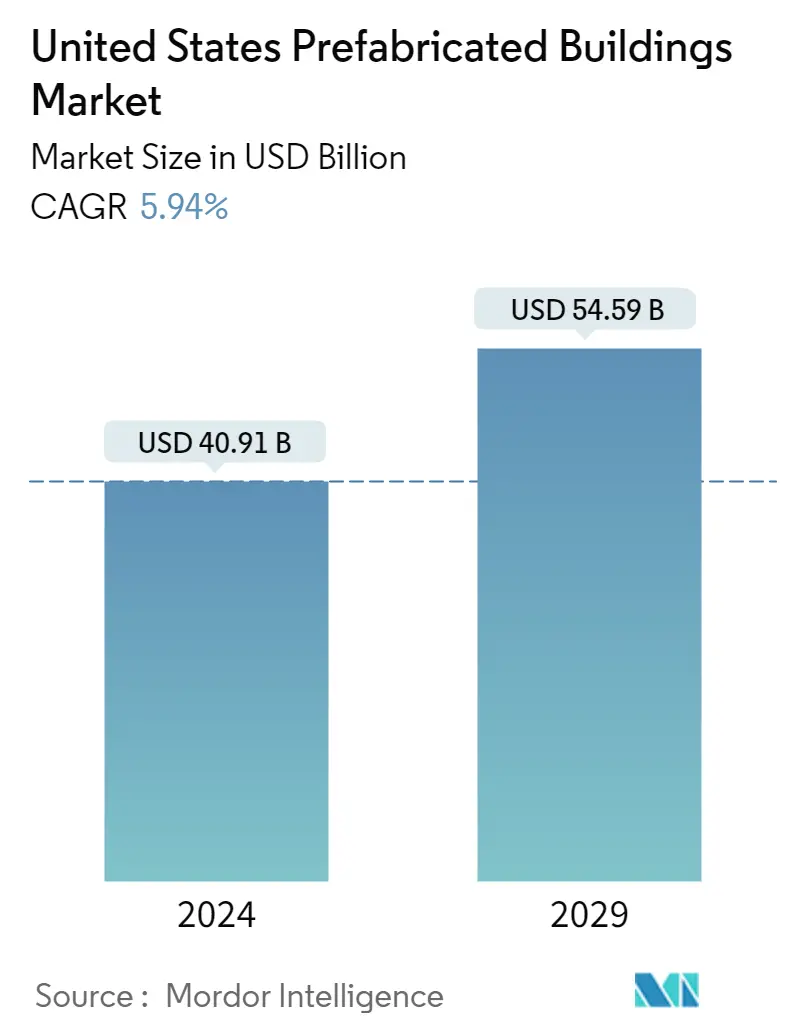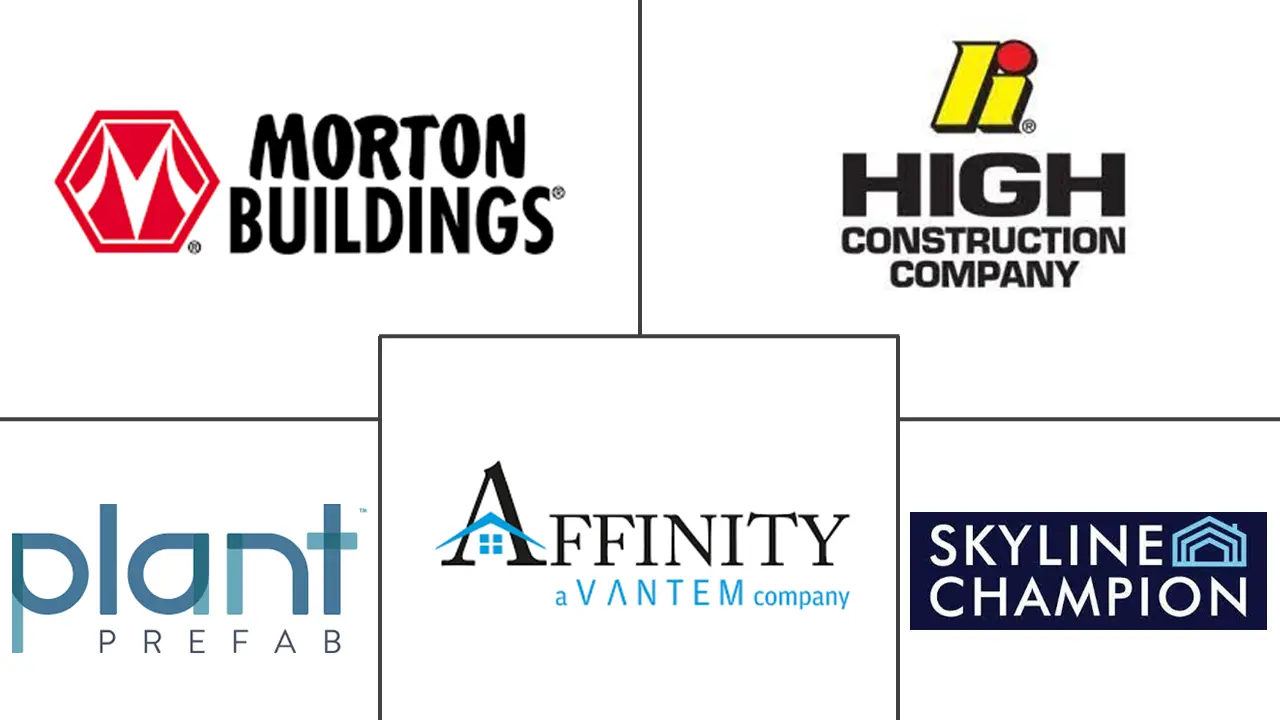Market Size of United States Prefabricated Buildings Industry

| Study Period | 2019 - 2029 |
| Base Year For Estimation | 2023 |
| Market Size (2024) | USD 40.91 Billion |
| Market Size (2029) | USD 54.59 Billion |
| CAGR (2024 - 2029) | 5.94 % |
| Market Concentration | Medium |
Major Players
*Disclaimer: Major Players sorted in no particular order |
US Prefabricated Buildings Market Analysis
The United States Prefabricated Buildings Market size is estimated at USD 40.91 billion in 2024, and is expected to reach USD 54.59 billion by 2029, growing at a CAGR of 5.94% during the forecast period (2024-2029).
The building sector in the United States is heavily reliant on supplies of steel, copper, aluminum, stone, and fixtures from other countries, many of which come from China.
Manufactured housing is a large segment with high demand in the US prefabrication construction market. The prefabrication market in the country is also witnessing demand for prefabricated housing types, including panelized and pre-cut. The drive to make housing more affordable, especially in high-demand areas like the San Francisco Bay area, encourages developers to move toward prefabrication solutions.
The prefabrication of multifamily buildings is still in its infancy in the United States. Most of the prefabricated multifamily buildings consist of wood-framed units that evolved from the products made by the manufacturers of single-family, mobile, and modular homes. Until recently, few steel modular experiments were undertaken. A Seattle company, Blokable, built its first steel units at its factory in Vancouver, Washington, for a 24-unit project in Edmunds, Washington.
The preference toward manufactured home solutions in the United States has been witnessing continuous growth, as this serves as the cost-effective alternative to conventional construction methods. This increasing preference is increasing the demand for manufactured homes, resulting in an increase in price in the country and modular housing.
US Prefabricated Buildings Industry Segmentation
The US prefabricated buildings market covers the growing trends and projects in prefab building markets, like commercial construction, residential construction, and industrial construction. The report also covers the industry along with the type of material used, like concrete, timber, glass, metal, and others. Along with the report's scope, it also analyses the key players and the competitive landscape in the US prefabricated buildings market. The impact of COVID-19 has also been incorporated and considered during the study.
The United States prefabricated buildings industry is segmented by material type (concrete, glass, metal, timber, and other material types) and application (residential, commercial, and other applications (infrastructure and industrial)). The report offers the market size of prefabricated buildings in the United States and forecasts in value (USD) for all the above segments.
| Material Type | |
| Concrete | |
| Glass | |
| Metal | |
| Timber | |
| Other Material Types |
| Application | |
| Residential | |
| Commercial | |
| Other Applications ( Industrial, Institutional, and Infrastructure) |
United States Prefabricated Buildings Market Size Summary
The United States prefabricated buildings market is poised for significant growth, driven by the increasing demand for cost-effective and efficient construction solutions. The market is characterized by a strong reliance on imported materials such as steel, copper, and aluminum, with a notable dependency on supplies from countries like China. The sector is witnessing a surge in demand for manufactured housing and various prefabricated housing types, including panelized and pre-cut options, as developers seek to make housing more affordable in high-demand areas. Despite the nascent stage of multifamily prefabrication, the market is evolving with innovations like steel modular units, exemplified by projects from companies such as Blokable. The integration of Building Information Modeling (BIM) is enhancing project quality, reducing costs, and improving schedule performance, making it increasingly popular in commercial and institutional projects across the country.
The market landscape is highly competitive and fragmented, with no single dominant player, but it is expected to expand due to increased investments in prefab construction and upcoming major projects. Key industry players include Skyline Champion Corporation, Plant Prefab, and Z Module, among others. The construction industry is also adapting to challenges such as skilled labor shortages and rising material costs, with a focus on modernization and sustainability. The rise of green building concepts and technological advancements like BIM are set to play a crucial role in the industry's future. The market is attracting interest from venture capitalists and experts from other manufacturing sectors, indicating ample opportunities for growth. Recent expansions and acquisitions by companies like Morton Buildings and WillScot Mobile Mini further underscore the market's potential and the ongoing shift towards modular and prefab construction solutions.
United States Prefabricated Buildings Market Size - Table of Contents
-
1. MARKET INSIGHTS
-
1.1 Current Market Scenario
-
1.2 Technological Trends
-
1.3 Insights on Supply Chain/Value Chain Analysis of the Prefabricated Buildings Industry
-
1.4 Brief on Different Structures Used in the Prefabricated Buildings Industry
-
1.5 Cost Structure Analysis of the Prefabricated Buildings Industry
-
1.6 Impact of COVID 19
-
-
2. MARKET SEGMENTATION
-
2.1 Material Type
-
2.1.1 Concrete
-
2.1.2 Glass
-
2.1.3 Metal
-
2.1.4 Timber
-
2.1.5 Other Material Types
-
-
2.2 Application
-
2.2.1 Residential
-
2.2.2 Commercial
-
2.2.3 Other Applications ( Industrial, Institutional, and Infrastructure)
-
-
United States Prefabricated Buildings Market Size FAQs
How big is the United States Prefabricated Buildings Market?
The United States Prefabricated Buildings Market size is expected to reach USD 40.91 billion in 2024 and grow at a CAGR of 5.94% to reach USD 54.59 billion by 2029.
What is the current United States Prefabricated Buildings Market size?
In 2024, the United States Prefabricated Buildings Market size is expected to reach USD 40.91 billion.

